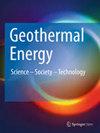摘要
地热资源是一种资源丰富、分布广泛、环境友好的可再生能源,其利用和成因研究具有重要意义。利用15个地热样点和2个冷水样点的水文地球化学资料,分析了区域温泉水的形成与演化。结果表明:该温泉以HCO3 - na型为主,另有HCO3·Cl-Na、HCO3·SO4-Na等水型。水化学组成受硅酸盐矿物溶解、蒸发岩风化和阳离子交换的控制。水岩相互作用导致B、I、Li等微量元素富集,其流动性反映了一个复杂的多相补给系统,具有不同的水地球动力学过程。利用硅焓法估算了原始储层温度范围为173.1 ~ 266.3℃。随着地热流体的上升,与冷水混合占59-93%。混合温度范围为58.22 ~ 135.43℃。水文和地球化学指标表明,II区系统封闭性强,流体停留时间长,径流缓慢;III区为中度封闭,存在次生水岩相互作用;I区是一个开放的循环,地下水补给迅速。该研究为认识阿里温泉水成因和区域地热资源可持续开发提供了科学依据和指导。然而,其局限性包括缺乏同位素约束和采样空间分辨率不足,这些都需要在未来的研究中加以解决。Geothermal resources are abundant, widely distributed, and environmentally friendly as a renewable energy source, making their utilization and genesis studies highly significant. In the Tibet's Ali region, geothermal potential is considerable but development is limited. Based on hydrogeochemical data from 15 geothermal sampling sites and 2 cold-water sampling sites, this study analyzes the formation and evolution of regional hot spring waters. Results show that the hot springs are predominantly of the HCO3–Na type, with other water types, including HCO3·Cl–Na and HCO3·SO4–Na. The hydrochemical composition is controlled by the dissolution of silicate minerals, weathering of evaporites, and cation exchange. Water–rock interactions cause enrichment of trace elements, such as B, I, and Li, and their mobility reflects a complex multiphase recharge system with varied hydrogeodynamic processes using the silica–enthalpy method to estimate the original reservoir temperature ranges from 173.1 to 266.3 °C. As the geothermal fluids ascend, mixing with cold water accounts for 59–93%. The mixed temperatures range from 58.22 to 135.43 °C. Hydrological and geochemical indicators suggest that Zone II exhibits strong system enclosure, long fluid residence time, and slow runoff; Zone III shows moderate enclosure with secondary water–rock interactions; Zone I represents an open circulation with rapid groundwater recharge. This study provides scientific basis and guidance for understanding the genesis of Ali hot spring waters and the sustainable development of regional geothermal resources. However, limitations include a lack of isotopic constraints and insufficient sampling spatial resolution, which should be addressed in future research.

 求助内容:
求助内容: 应助结果提醒方式:
应助结果提醒方式:


